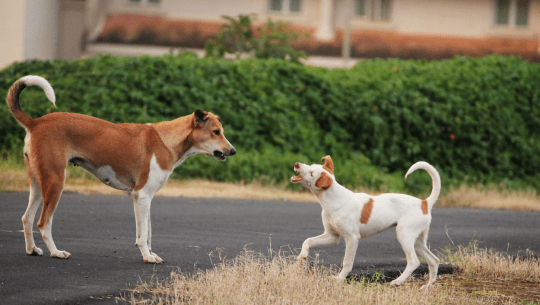We can work it out…

I hear dog owners frequently say ‘he needs telling’, ‘they will work it out’. This is usually in response to their dog pestering another dog to the point were the other dog reacts with some level of aggression. From a behaviourist’s point of view, this is misguided and displays a lack of understanding of what is happening in this scenario. Let me be clear — they will not ‘work it out’.
It is never a good idea to allow a dog to be put in a position where it’s only course of action is to show aggression. Dog’s, generally, have two courses of action available to them in a situation — this is fight or flight. If a dog cannot remove itself from a situation (flight), their only real course of action is to fight.
When a puppy is developing, it will learn from interacting with it’s mother and littermates. He will be put in his place if he plays too aggressively or bites too hard for instance. During this important period (3 to 14 weeks of age) the puppy will learn the most appropriate behaviour/s for situations he may find himself in.
Of course, when the dog is older it is essential to ensure you keep socialising your dog properly and correct bad behaviour and reward good behaviour. Failure to do this will result in problems.
I encountered a classic example, today, of letting them ‘work it out’. My dog, Ziggy, was playing with a group of dogs in the water. One dog, a male, was continuously trying to mount Ziggy. This was a neutered male, probably showing signs of dominant behaviour. The dog’s owner stated, when Ziggy bared her teeth, that he needed ‘telling’.
I explained why this was flawed thinking. By not correcting this dog, which I did, he was being allowed to exhibit dominant and undesirable behaviour. This was resulting in my dog being forced to react aggressively — never a good thing. In fact, if an owner allows their dog to get into situations where it has to behave with aggression, this can quickly become a learned behaviour that the dog will show with other dogs.
The dog that was making consistent attempts to mount other dogs should have been put on the lead until it calmed down. This is a form of punishment for the dog. After a minute or so, the dog can be let off the lead, if he continues with the behaviour, he should be interrupted each time he tries to approach the other dog, putting him back on the lead. He will, eventually, learn that his mounting behaviour results in him being put on the lead and prevented from interacting with other dogs.
The take home point here is to never allow your dog to pester other dogs in such a way that it forces an aggressive response. It is the owners responsibility to make sure their dog behaves appropriately. This takes time and effort. Owners should also take steps to remove their dog from situations that might elicit inappropriate responses from their dogs.
